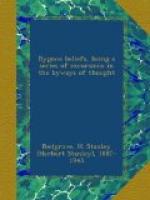[1] This is not quite an accurate definition, as “auguries” were also obtained from other animals and from celestial phenomena (e.g. lightning), etc.
Auguries were also drawn from the notes of birds, birds being divided by the augurs into two classes: (i) oscines, “those which give omens by their note,” and (ii) alites, “those which afford presages by their flight."[1] Another method of augury was performed by the feeding of chickens specially kept for this purpose. This was done just before sunrise by the pullarius or feeder, strict silence being observed. If the birds manifested no desire for their food, the omen was of a most direful nature. On the other hand, if from the greediness of the chickens the grain fell from their beaks and rebounded from the ground, the augury was most favourable. This latter augury was known as tripudium solistimum. “Any fraud practiced by the `pullarius’,” writes the Rev. EDWARD SMEDLEY, “reverted to his own head. Of this we have a memorable instance in the great battle between Papirius Cursor and the Samnites in the year of Rome 459. So anxious were the troops for battle, that the `pullarius’ dared to announce to the consul a `tripudium solistimum,’ although the chickens refused to eat. Papirius unhesitatingly gave the signal for fight, when his son, having discovered the false augury, hastened to communicate it to his father. `Do thy part well,’ was his reply, `and let the deceit of the augur fall on himself. The “tripudium” has been announced to me, and no omen could be better for the Roman army and people!’ As the troops advanced, a javelin thrown at random struck the `pullatius’ dead. `The hand of heaven is in the battle,’ cried Papirius; `the guilty is punished!’ and he advanced and conquered."[1b] A coincidence of this sort, if it really occurred, would very greatly strengthen the popular belief in auguries.
[1] PLINY: Natural History, bk. x. chap. xxii. (BOSTOCK and RILEY’S trans., vol. ii., 1855, p. 495).




